 |
|
So This Physicist Walks into a Bar... by Judy Jackson
Potential pick-up lines from particle physics made Rosen’s point about the
need for improved physics communication, part of his remarks to Fermilab
users at the 35th Users’ Annual Meeting, held at Fermilab on June 10 and 11.
Also on the agenda: Fermilab Director Mike Witherell on the state of the
laboratory, the Beams Division’s Dave McGinnis on the state of the Tevatron
and Run II, and Fermilab users on the state of experiments and projects past,
present and to come. Via videotape, Stanford Linear Accelerator Center
Director Jonathan Dorfan led users on a brisk but comprehensive tour of
SLAC science. Users discussed the perennial problem of what to do about
falling federal funding for physics. Chez Léon chef Tita Jensen served a
memorable dinner, and users ended the evening with what has become
una bella tradizione at the Users’ Meeting: meatballs, cannoli and grappa
at Festa Italiana in the Barn, hosted by Fermilab’s Italian delegation.
It was our annual reminder that Fermilab is not just a physics laboratory
but a unique community of scientists.
Eyes on Run II
Rosen reminded the audience how much is at
stake.
“There is much interest in Washington as to the
progress of Run II,” Rosen said. “It is essential
for Run II to succeed. All of us on the outside
are waiting for new physics results. Run II at the
Tevatron is a key issue for the whole physics
program.”
Witherell described efforts to raise the Tevatron’s
collision rate, showing a plot of rising accelerator
luminosity over recent months.
“Run II is the most important element of our
program,” he said. “There has been much progress
since March. Some solutions have been found.
There are many more to go. The general strategy
is to improve the antiproton efficiency, improve the
proton intensity at low beta [where collisions occur],
and improve the [antiproton] stacking rate. In
October, we will integrate the Recycler. Every
doubling of the data sample makes possible new
possibilities and opens up a whole roster of new
physics results.”
Run II at the Tevatron is a key issue
for the whole physics program. –Peter Rosen
“The Tevatron Department helix work has paid off,”
McGinnis said, describing adjustments to the paths
of particles orbiting the accelerator. “The big thing
missing is the amount of pbars going to low beta.
Only thirty percent of the pbars are getting through
to collision. Are there enough pbars? Yes. There
are plenty of pbars coming out of the Accumulator,
but they are not making it to low beta. They are
getting lost when they come out of the Main
Injector and go into the Tevatron. The problem
is interbeam scattering.”
McGinnis described three steps to fixing the
problem: better helices, smaller beam size and
bigger beam apertures. He said the current
shutdown would lead to improved stochastic
cooling for a smaller antiproton beam size and
described a new “dual lattice” operation also
designed to deliver more antiprotons to the
collision points.
On the bride side
All was not low-luminosity angst. Rosen expressed “a note of confidence” in the laboratory, based on
the turnaround in the NuMI construction project.
Witherell concurred.
“The excavation of NuMI’s onsite tunnel is
complete,” he said. “Two-hundred-twenty-five of
the 486 planes of the MINOS detector are in place.
The NuMI project management deserves much
credit. Further, MiniBooNE is ready to go, with the
first neutrinos right around the corner in July 2002.”
Users learned of progress on Fermilab’s
contributions to the Large Hadron Collider at
CERN. Witherell reported that the Fermilab-led
U.S. program for the Compact Muon Solenoid
detector at the LHC has begun to prepare for the
transition from detector construction to the CMS
research program. He noted that the US LHC
accelerator program, also led by Fermilab is
73 percent complete, and has received excellent
reviews.
E791, the gift that keeps on giving
Fixed-target experiments at Fermilab ceased taking
data in 1999. Nevertheless, an overview of fixedtarget
experiments by the University of Virginia’s
Sasha Ledovskoy presented an astonishing
number of recently published fixed-target results—
including new results just published by E791, an
experiment to study the decay of charm particles,
which stopped taking data in 1991.
“There are many constraints on moving forward
with the plan,” Witherell said, “with a federally
imposed annual cap of $19 million in funding for
linear collider R&D funding, including a cap of
$3 million at Fermilab. When the government
responds with more funding for linear collider R&D,
that will be a sign that they are getting serious
about responding to our field’s recommendations.”
Rosen described the formation of an international
linear collider steering group that expects to meet
in Amsterdam in July.
“How can we put the linear collider on a path to
construction?” he asked. “We all recognize that the
linear collider will be an international project from
the word go. Governments need to find how they
will work together. In this country, a strong group
has been established to guide R&D and physics
and to help make the case to the Sixpacks.”
Heads up, Joe and Janine. A linear collider may
be coming soon to a barroom near you.
On the Web: Streaming Video
|
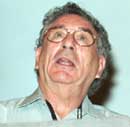 Picture your local watering hole. That’s where the
Department of Energy’s Peter Rosen recommends
field-testing the message of particle physics. Sidle
up to “Joe and Janine Sixpack,” Rosen suggests,
and lay some neutrinos on them. If the skimpy little
particles don’t do it for the Sixpacks, see how they
respond to superconducting magnet technology or
the World Wide Web—whatever it takes to get the
barroom buzzing over baryons.
Picture your local watering hole. That’s where the
Department of Energy’s Peter Rosen recommends
field-testing the message of particle physics. Sidle
up to “Joe and Janine Sixpack,” Rosen suggests,
and lay some neutrinos on them. If the skimpy little
particles don’t do it for the Sixpacks, see how they
respond to superconducting magnet technology or
the World Wide Web—whatever it takes to get the
barroom buzzing over baryons.
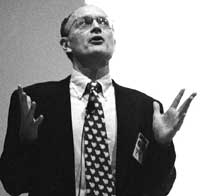 Concern for the progress of Run II at the Tevatron
permeated the Users’ Meeting, as it does all of
Fermilab. As the users met, the Fermilab Beams
Division was winding up a two-week shutdown
for the installation of new devices to raise the
accelerator’s collision rate from what Witherell
called Run II’s “disappointing start.”
Concern for the progress of Run II at the Tevatron
permeated the Users’ Meeting, as it does all of
Fermilab. As the users met, the Fermilab Beams
Division was winding up a two-week shutdown
for the installation of new devices to raise the
accelerator’s collision rate from what Witherell
called Run II’s “disappointing start.”
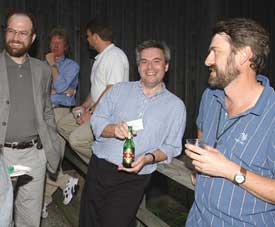 The Beams Division’s Dave McGinnis gave users
still more specifics on the division’s ongoing push
for higher luminosity.
The Beams Division’s Dave McGinnis gave users
still more specifics on the division’s ongoing push
for higher luminosity.
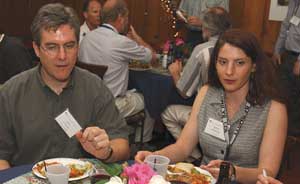 “A year ago, NuMI was in serious trouble,” Rosen
said. “The laboratory has turned the project around,
and now we all are confident that NuMI will
succeed.”
“A year ago, NuMI was in serious trouble,” Rosen
said. “The laboratory has turned the project around,
and now we all are confident that NuMI will
succeed.”
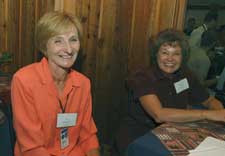 Along with reports from current experiments and
proposed projects came consideration of the
longer-term future of particle physics. Witherell
cited the recently completed High Energy Physics
Advisory Panel plan that proposed a linear collider
in the US.
Along with reports from current experiments and
proposed projects came consideration of the
longer-term future of particle physics. Witherell
cited the recently completed High Energy Physics
Advisory Panel plan that proposed a linear collider
in the US.